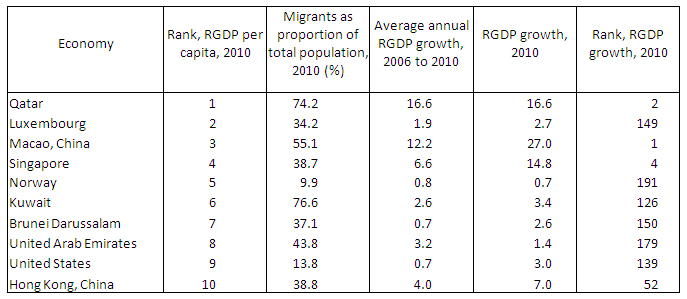 Seven of the world’s ten richest economies by real gross domestic product (RGDP) per capita are in Asia and the Middle East, and all have sizeable populations of foreign migrant workers (FMWs) that have contributed greatly to growth. The proper handling of FMW involvement in an economy is crucial for continued prosperity.
Seven of the world’s ten richest economies by real gross domestic product (RGDP) per capita are in Asia and the Middle East, and all have sizeable populations of foreign migrant workers (FMWs) that have contributed greatly to growth. The proper handling of FMW involvement in an economy is crucial for continued prosperity.
Despite the widespread reliance of many economies on FMWs, much of the related research has focused on the narrower issue of the impact of foreign labor on local employment and the resultant downward pressure on local wages (e.g., Borjas et al. 1996. Goto 1998). In comparison, very little evaluation has been done on the extent of their contribution to economic growth across countries. One reason for this omission could be that for completeness, any evaluation of the contributions of FMWs would have to take into account not only direct economic effects, such as the potential crowding out of employment of competing local workers, but also the long-term consequences for the host country’s productivity and competitiveness. While the availability of FMWs helps countries with small populations, there has not been much discussion about whether the fact that such workers are usually transient could ultimately have consequences for the accumulation of experience and learning in the host country. If such a problem occurred, it could manifest in the form of poorer productivity performance (Tan 2012). I aim to discuss this issue from the perspective of selected Asian and Middle Eastern economies whose dependence on FMWs has been a prominent policy issue.
Contribution of FMWs
Tables 1 and 2 highlight how important FMWs are to these flourishing economies. Of the ten richest economies in terms of RGDP per capita in 2010, Qatar ranked first and Singapore fourth (Table 1). Qatar’s FMW numbers stood at 74.2% of the total population—nearly double Singapore’s 38.7%. Table 2 shows the top economies in employment growth, and again, Qatar and Singapore stand out, having the first and ninth fastest rates of job growth from 2006 to 2010. Despite the magnitudes of the migrant workforces, Table 1 also suggests that there is more to economic performance in terms of RGDP growth than access to FMWs alone.
Table 1. Top 10 Economies by RGDP Per Capita and Migrants as Proportion of Population

Source: databank.worldbank.org
RGDP = real GDP.
Table 2. Top 10 Economies Employment Growth, 2006–2010, 2001–2005
 Source: databank.worldbank.org
Source: databank.worldbank.org
The seven Asian and Eastern economies in Table 1 comprise oil-rich Gulf states and East Asian economies. In terms of the pace of increase in employment, Qatar’s experience is closest to that of Singapore. Following the 2008 global financial crisis, these two economies created jobs far in excess of their natural populations’ capacity to meet the demand for workers. This was welcome news for the two countries and stood in stark contrast to the chronic unemployment afflicting many of the world’s large, well-established economies.
The lack of large native population bases in Qatar and Singapore meant that their employment growth in recent years has been made possible through the availability of FMWs. Qatar’s economic success has been a relatively recent phenomena, occurring only after a change of leadership in the early 1990s. To exploit its oil wealth, it turned to foreign workers. In contrast, Singapore had been reliant on FMWs since its independence. However, after experiencing downturns in 2001 and 2003, Singapore’s government embarked on a rapid upgrading of its transportation, tourism, and housing infrastructure. The resulting jobs boom in the services and construction sectors more than made up for the relatively tepid performance of the export-dependent manufacturing sector (National Population and Talent Division, Singapore 2013).
Three key facts are relevant to FMWs’ contribution to the success of these economies. First, the phenomenon of relying on migrant workers is not new. At various times in history, fast-growing economies have relied on migrant workers to exploit the momentum of the economic opportunities that have come their way. Second, the high employment growth rates for the economies in question are a recent phenomenon, as the rates have been lower in the past. For example, Table 2 illustrates that Qatar’s employment growth rate from 2001 to 2005 was one-third of that from 2006 to 2010. Singapore’s employment growth rate was also much lower from 2001 to 2005 than from 2006 to 2010. And third, migrant population proportions can drop sharply as illustrated by Kuwait, Qatar, and the United Arab Emirates in Figure 1.
Figure 1. Migrants as Proportion of Total Population, 1995–2010

Source: World Bank’s World Development Indicators database available at: data.worldbank.org Accessed December 2012.
Hence, despite their rarity, the high employment growth rates of Singapore and Qatar are not new. What is unusual, especially in Singapore’s case, is the pace of the increase in recent years and the continuing demand by local employers for FMWs. This is evident from the concerns about the tightening of restrictions on the supply of FMWs, which includes a combination of higher levies on each FMW employed and more stringent quotas requiring employers to match their FMW headcount with a prescribed number of Singaporean employees.
Unique Challenges
The sheer magnitude of the proportions of FMWs in Qatar and Singapore, as well as in the other highlighted economies, suggests that their contributions and management present policy implications that differ greatly from Western countries. Australia, New Zealand, and the United States also rely on FMWs but handle the issue differently because they do not have the same stringent physical limitations that restrict a small island nation like Singapore. By accommodating the issue from an immigration standpoint, such countries have systematically acculturated their FMWs. Indeed, it is common for many prospective migrants to enter these countries as young students, and then remain as permanent residents or as new citizens.
The rising inflow of FMWs in Asia and the Middle East suggests that their aim is to meet short-term economic needs rather than to stay long term. Such FMWs could be managed based on a short-term perspective, for example, by housing those at the lower end of the income scale in dormitories. It should not be surprising then that the narrow scope of the individual migrant’s experience in the host economy and lack of acculturation would limit the depth of the involvement of such FMWs in productivity improvements.
From the perspective of economic strategy, however, the contributions of FMWs extend beyond their contributions to immediate economic needs. A key aspect of the employment of FMWs is their role in counter-cyclical policy management. This may account for the declines in the migrant proportions for the Gulf states shown in Figure 2.
Singapore’s handling of unemployment is a case in point. Figure 2 shows that in two of Singapore’s last three contractions in annual economic output, the labor market downturn post-dated the contraction. However, the last downturn, caused by the 2008 global financial crisis, was unusual for the net gain in employment during the year of the recession in 2009. The net gain came about through the government’s innovative job credits scheme that tilted the cost advantage to favor Singaporean workers over their FMW counterparts. This example emphasizes the importance of wage costs in influencing the demand for FMWs. As Asian and Middle Eastern economies develop, wage relativities will change, which will shift the pattern of FMW employment in the coming years.
The emphasis on skills over costs is the guiding principle behind the system of levies and quotas that Singapore uses to manage its foreign manpower requirements (Ministry of Manpower, Singapore 2013). Foreigners working in Singapore are categorized according to their roles, educational qualifications and skills level, with the latter proxied by the monthly remuneration of the individual concerned. Employers who satisfy quota requirements may employ foreign personnel under the appropriate quota limits subject to the payment of a levy. The system is graduated to discourage excessive reliance on low-wage FMWs, in favor of the more highly qualified and skilled ones.
Figure 2. Annual Economic Growth and Employment Changes in Singapore, 1992–2010

Source: RGDP (real gross domestic product) growth is from the Annual Economic Survey, published by Singapore’s Ministry of Trade and Industry; employment growth is from the Report on the Labour Force, published by Singapore’s Ministry of Manpower.
Looking to the Future
In recent years, the reliance on FMWs appears to have been driven by short-term economic contingencies rather than any long-term strategic plan. FMWs bring enormous benefits to their host economies, and their home countries benefit from the incomes they repatriate. As the 21st century progresses and Asia’s economic march continues, there are concerns in some of the fastest growing economies about potential labor shortages. Ironically, some will occur in previously populous countries that earlier had surplus labor, which constituted the first waves of FMWs.
In some countries, such as Singapore, there is concern that FMWs are “crowding out” opportunities for citizens. The greatest economic challenge that countries with large number of FMWs face is how to manage their reliance on FMWs to ensure the viability, vibrancy and unfettered movement of talent and ideas for the coming decades.
Policymakers dealing with labor issues need to anticipate a much more open and integrated pan-Asian economic landscape. In such a setting, workers are likely to be more inclined to operate regionally rather than be bound by national boundaries. In small economies like Brunei Darussalam; Hong Kong; and Singapore, the disdain for national boundaries will be even stronger. Ultimately, the natural progress of economic development will favor the freer movement for FMWs, not less. So early planning of FMWs involvement in an economy is crucial. At the same time, more restrictive policies should be avoided, and instead governments should recognize that the inevitable shift in wage relativities will affect employer demand for FMWs.
_____
References:
Borjas, G. et al. 1996. Searching For the Effect of Immigration on the Labor Market. American Economic Review. Volume 86. pp. 246–251. 2 May
Goto, J. 1998. The impact of migrant workers on the Japanese economy: Trickle vs. flood. Japan and the World Economy. 10 (1). pp. 63–83.
Ministry of Manpower. 2013. Levies and quotas for hiring foreign workers. Singapore. (accessed 5 February 2013).
National Population and Talent Division. 2013. A Sustainable Population for a Dynamic Singapore: Population White Paper. Singapore. (accessed 5 February 2013).
Tan, R. 2012. Performance of the Singapore Labour Market. Presentation at the Singapore Economic Policy Forum, organized by the Economic Society of Singapore. (accessed 5 February 2013).
The Wall Street Journal. 2013. Dangerous curve ahead, the IMF warns China (accessed 20 February, 2013).



